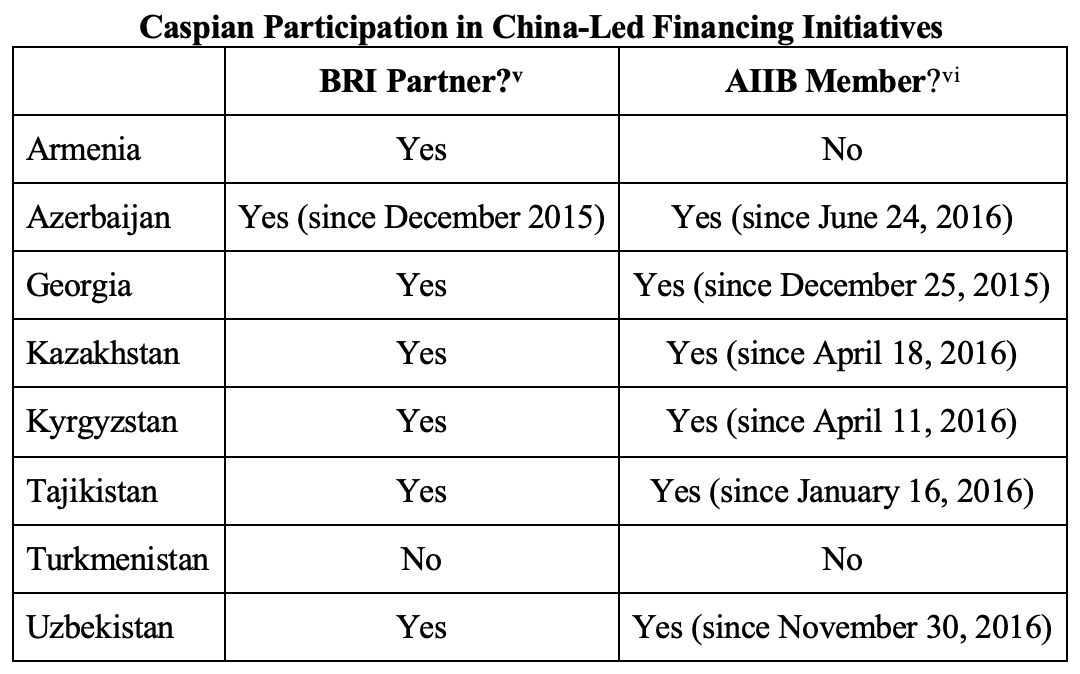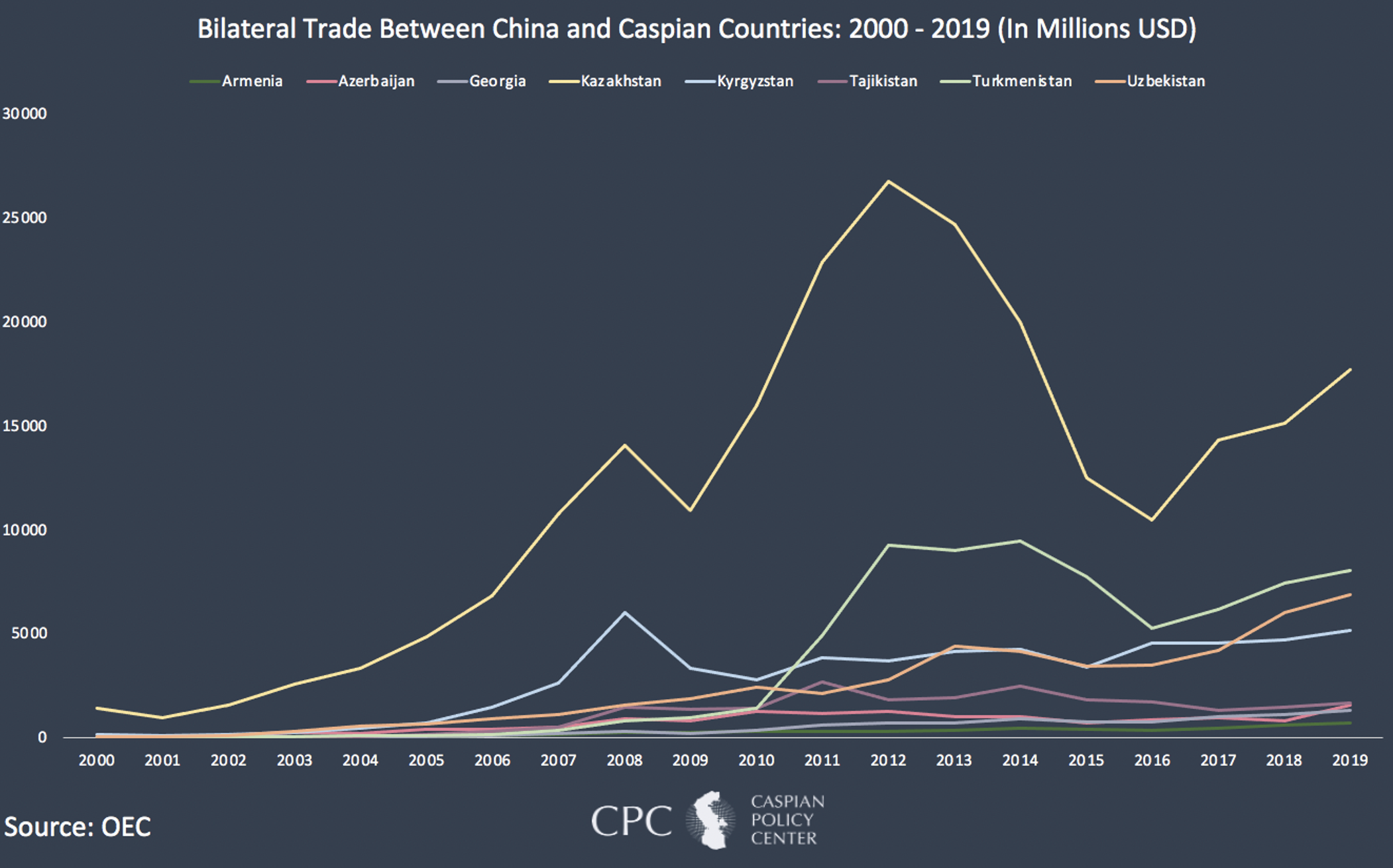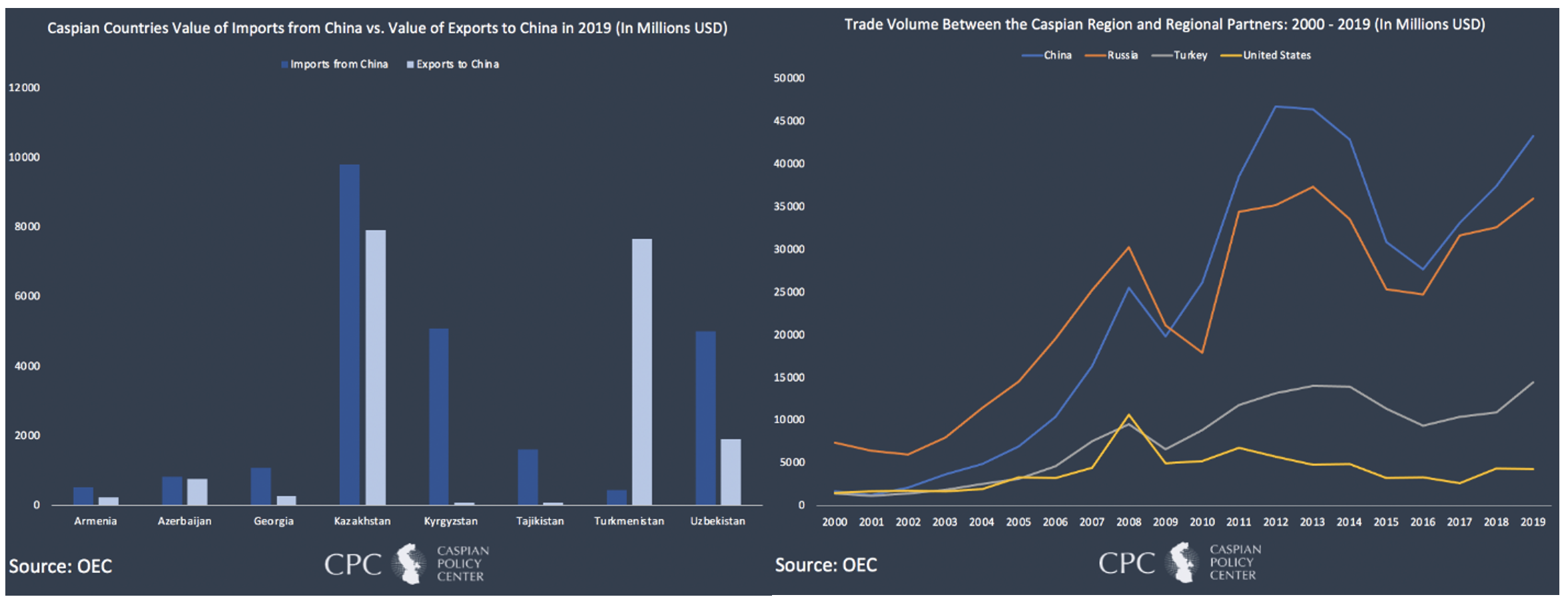China’s Growing Involvement in the Caspian Region
Recent Articles
Author: Dante Schulz
01/26/2022
This piece is part of a series by Dante Schulz and CPC’s Senior Fellows that researches the bilateral relationship between China and the 8 Caspian countries. CPC will release one article on each of the countries and publish a volume encompassing all the research after the last article is released."
Introduction
China has nurtured its relationships with the Caspian region since the countries gained independence from the Soviet Union in 1991. Considered historically and culturally a part of Russia’s realm, the Caspian region has explored its relationships with other partners, including the European Union, the United States, and China. As a result, each country in the Caspian region has developed a unique foreign policy that interacts differently with Chinese ambitions in the region. Over the past three decades, the three South Caucasus countries and the five in Central Asia have engaged with China on multiple fronts, such as attracting Chinese foreign direct investment (FDI), acceding to Chinese-led multilateral security and economic platforms, and increasing their trade portfolio with Beijing.
China launched its Belt and Road Initiative (BRI) in 2013 to extend Beijing’s investment and development initiatives westward.i The BRI, once hailed as the ‘New Silk Road’ is reminiscent of the original silk road, which linked imperial China with civilizations in the Middle East and Europe via Central Asian overland trade routes. President Xi’s initiative includes numerous railways, highways, shipping ports, improved border crossings, and energy pipelines to transform the Eurasian landmass into a web of connected states. The two most probable routes both traverse the Caspian Region. The first aims to connect Urumqi, China, with Duisburg, Germany. The second plans to link Urumqi with Kars, Turkey. Both proposed routes would utilize existing and new rail infrastructure. In addition, the China-Central Asia-West Asia BRI Corridor has three possible routes, each connecting Kashgar, China, with Tehran, Iran, via Kazakhstan, Kyrgyzstan, Uzbekistan, and Turkmenistan.ii The infusion of large-scale modern infrastructure will join Europe and the Middle East with China. The Caspian region serves as the linchpin to China’s overland trade route ambitions.
Multiple countries in the Caspian region have also signed on to the China-led Asian Infrastructure Investment Bank (AIIB). The bank debuted in 2016 to rival the U.S.-led World Bank and revitalize the Asia-Pacific region with co-financing infrastructure projects.iii Several Caspian countries have become founding members of the bank, such as Azerbaijan, Georgia, Kazakhstan, Kyrgyzstan, Tajikistan, and Uzbekistan.iv This Chinese international development bank has provided an additional mechanism to link China with the Caspian region by introducing a new source of capital for large-scale infrastructure projects.

Bilateral trade relations between China and its Caspian partners have greatly expanded over the last two decades. China ranks among the top 10 destinations for Caspian exports in all Caspian countries and is the largest importer of goods from Kazakhstan and Turkmenistan. Bilateral trade is unbalanced heavily in China’s favor, and most Caspian countries are in a trade deficit with China. Even the two Caspian countries that have a trade surplus with China, [name them], primarily export hydrocarbons. While these countries benefit from heightened profit from their trade relationship with China, sustaining a trade relationship with Beijing based on only one resource could prove detrimental in the event of uncontrollable international economic and political forces. In fact, most exports to China from the Caspian region are concentrated in hydrocarbons and mineral extraction to fuel China’s rapid economic development. On the other hand, imports from China to the region are much more diverse.


China is also poised to become a major security player in the Caspian region. Beijing is a prominent supplier of military defense technologies to several countries in the region, including Armenia, Azerbaijan, Kazakhstan, Kyrgyzstan, and Tajikistan. These sales allow countries to offset their dependence on Russia or Turkey for military equipment acquisition. Moreover, China paved the way for regional security cooperation by creating the Shanghai Cooperation Organization (SCO), a multilateral framework comprising China, India, Kazakhstan, Kyrgyzstan, Russia, Pakistan, Tajikistan, and Uzbekistan, and recently Iran, to manage issues related to combatting terrorism, illegal drug trafficking, and interregional conflict.vii China’s policy of non-interference in the domestic affairs of other states has granted it an opportune position to engage with multiple countries in the region on security issues without becoming entangled in regional or internal conflicts.
While Chinese engagement is viewed by regional governments as a positive mechanism to develop the Caspian region’s infrastructure and incorporate it into global trade and transit routes, many local communities have voiced concerns over growing Chinese involvement in the region. Some groups, particularly those in Kazakhstan and Kyrgyzstan, have been vocal in their opposition to Chinese-led and Chinese-financed projects, often staging rallies to demonstrate their resistance. Governments in the region have been swift to clamp down on this form of dissent to avoid upsetting Beijing but, nonetheless, growing resentment towards China has been brewing in the region.
The Caspian Policy Center has analyzed the bilateral relationships between China and each country in the South Caucasus and Central Asia since independence from the Soviet Union in 1991. While the eight countries in this series have all followed a similar trend towards bettering relations with Beijing, each has also employed a unique strategy to engage with China financially and politically. Every week, the Caspian Policy Center will publish a new Caspian country profile spotlighting China’s involvement in the region.
I Chatzky, A. & McBride, J. (2020, January 28). China’s Massive Belt and Road Initiative. Council on Foreign Relations. https://www.cfr.org/backgrounder/chinas-massive-belt-and-road-initiative.
II The World Bank. (June 2020). South Caucasus and Central Asia: The Belt and Road Initiative Armenia Country Case Study. The World Bank. Retrieved October 27, 2020, from https://openknowledge.worldbank.org/bitstream/handle/10986/34120/South-Caucasus-and-Central-Asia-The-Belt-and-Road-Initiative-Armenia-Country-Case-Study.pdf?sequence=4&isAllowed=y.
III Wong, S. (2016, January 15). China launches new AIIB development bank as power balance shifts. Reuters. https://www.reuters.com/article/us-asia-aiib-investment/china-launches-new-aiib-development-bank-as-power-balance-shifts-idUSKCN0UU03Y.
IV Dadashova, G. (2015, April 15). Azerbaijan becomes AIIB founding member. Azernews. https://www.azernews.az/business/80501.html.
V Nedopil, C. (2021). Countries of the Belt and Road Initiative. Green Finance & Development Center. https://greenfdc.org/countries-of-the-belt-and-road-initiative-bri/.
VI Asian Infrastructure Investment Bank. (2021, October 13). Members and Prospective Members of the Bank. Asian Infrastructure Investment Bank. https://www.aiib.org/en/about-aiib/governance/members-of-bank/index.html.
VII (2018, June). The evolution of the Shanghai Cooperation Organisation. IISS, (24). https://www.iiss.org/publications/strategic-comments/2018/shanghai-cooperation-organisation.